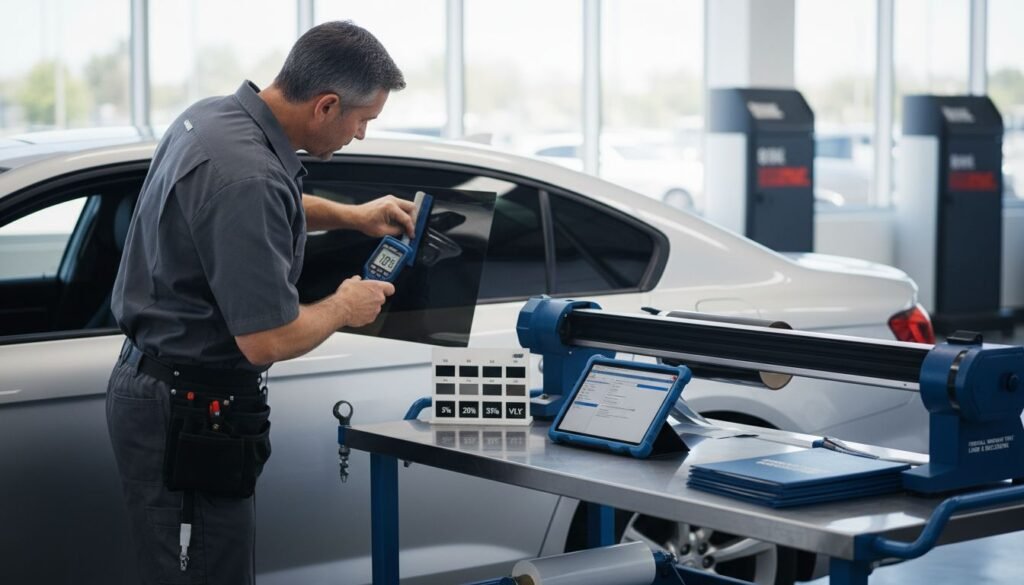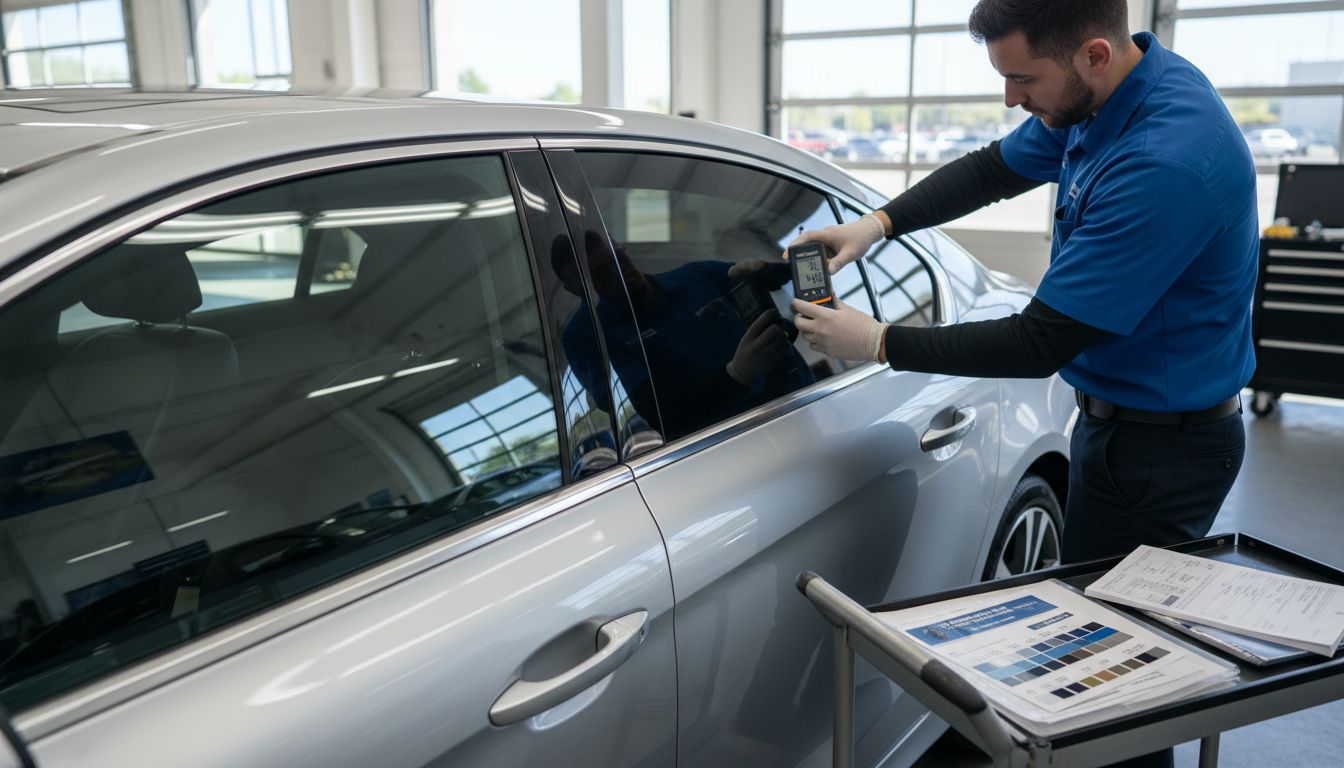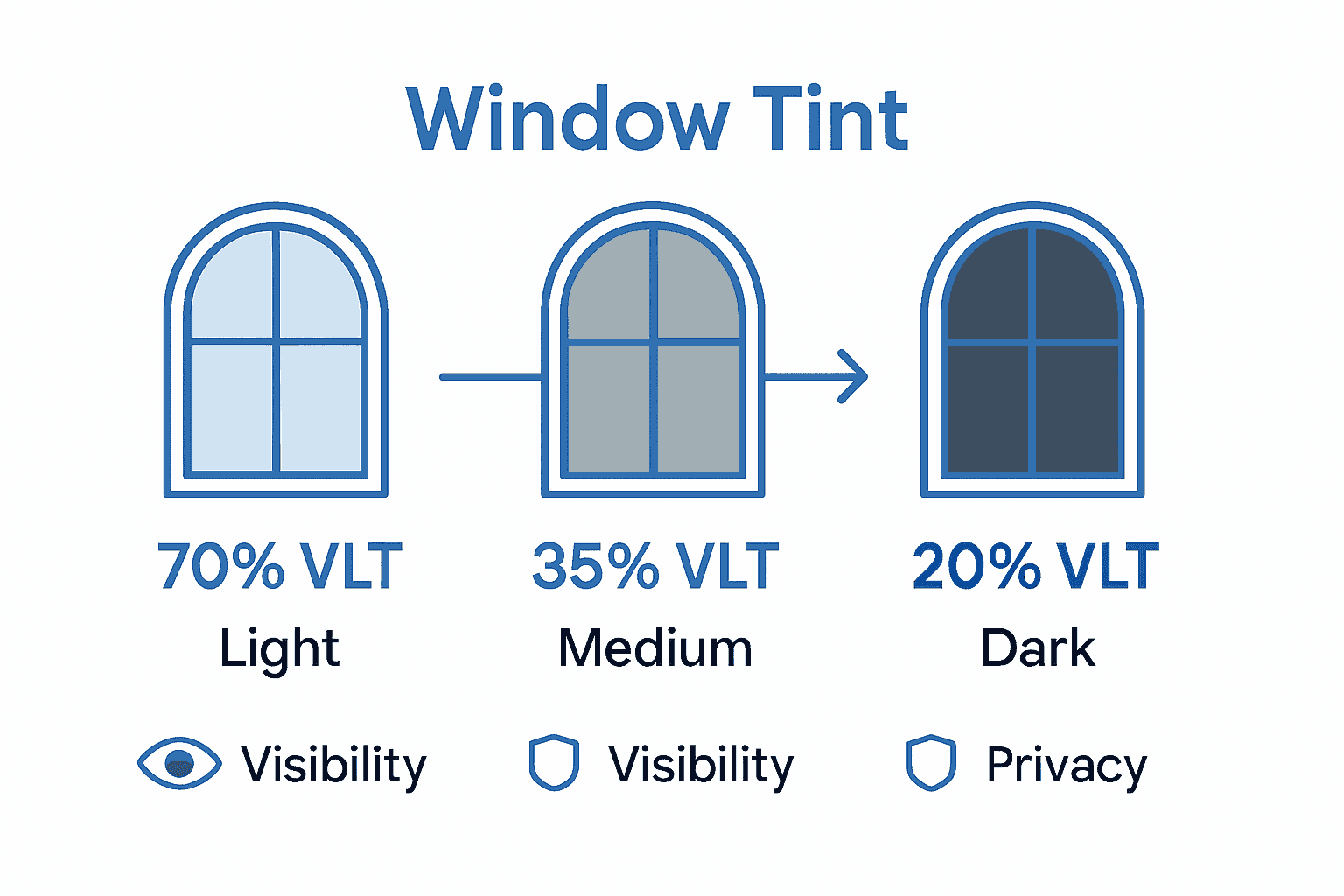
Did you know some countries allow only 20 percent visible light through car windows, while others ban dark tints altogether? These legal limits shape both the appearance and safety of every vehicle on the road. Car owners and auto pros alike face strict rules, from tint percentage restrictions to precise measurement requirements. Knowing the latest compliance standards helps you avoid fines, protect your passengers’ privacy, and maintain road safety standards.
Table of Contents
- Window Tinting Legal Limits Defined
- Categories of Window Tint and Measurement
- Global Regulations and Key Differences
- Installer Compliance and Client Responsibilities
- Risks, Penalties, and Common Violations
Key Takeaways
| Point | Details |
|---|---|
| Regulatory Framework | Window tinting legal limits vary by jurisdiction, balancing visibility, privacy, and safety. Knowledge of these regulations is essential for compliance. |
| Visible Light Transmission (VLT) | Measurement of tint darkness is based on VLT percentages, which differ for specific windows and vehicle types. Accurate assessment is crucial for installers. |
| Installer and Client Responsibilities | Both parties must ensure compliance with local laws, including accurate VLT measurement and clear communication of legal implications. |
| Risks of Non-Compliance | Violations can result in significant penalties, including fines and vehicle inspections. Prioritizing compliance protects both installers and clients from legal repercussions. |
Window Tinting Legal Limits Defined
Window tinting legal limits represent a critical regulatory framework that governs the permissible darkness of vehicle window films across different jurisdictions. According to research from Mendeley Data, these regulations are designed to balance multiple critical considerations including driver visibility, passenger privacy, and law enforcement safety needs.
The primary metric for measuring window tint darkness is Visible Light Transmission (VLT), which represents the percentage of light permitted to pass through a vehicle’s window film. Wikipedia explains that these laws are established to ensure road safety by carefully regulating the darkness of vehicle window tinting. Typically, VLT percentages vary based on specific window location and vehicle type.
Key Aspects of Window Tinting Regulations
Window tinting legal limits generally encompass several important parameters:
- Front windshield tint restrictions
- Driver and passenger side window tint percentages
- Rear window tint darkness allowances
- Reflectivity and colour restrictions
Professional installers must meticulously understand these nuanced regulations to ensure compliance and avoid potential legal complications. For automotive professionals seeking comprehensive guidance, our guide on how window tint works provides additional context about tinting technologies and legal considerations.
Understanding these legal limits requires careful attention to local and regional variations. While general principles remain consistent, specific VLT percentages can differ dramatically between jurisdictions, making ongoing professional education essential for window tint installers.
Categories of Window Tint and Measurement
Window tinting is a sophisticated field with multiple categories defined by their Visible Light Transmission (VLT) percentages. According to Wikipedia, window tints are typically classified into three primary categories: light (70% VLT), medium (35% VLT), and dark (20% VLT) tints, each serving distinct functional and aesthetic purposes for automotive professionals.
The measurement of window tint involves precise Visible Light Transmission (VLT) calculations that determine how much light passes through the film. Professional installers must understand these nuanced measurements to ensure compliance with local regulations and meet client expectations. Our types of window tint guide provides comprehensive insights into these technical specifications.
Key Tint Categories and Characteristics
Window tint categories can be broken down as follows:
Here’s a comparison of window tint categories and their main characteristics:
| Tint Category | VLT Percentage | Visibility | Privacy | Common Application |
|---|---|---|---|---|
| Light Tint | 70% | High | Low | Front windows |
| Medium Tint | 35% | Moderate | Medium | Side windows |
| Dark Tint | 20% | Lower | High | Rear windows |
- Light Tint (70% VLT): Minimal light reduction, maximum visibility
- Medium Tint (35% VLT): Moderate light blocking, balanced aesthetic
- Dark Tint (20% VLT): Significant light reduction, enhanced privacy
Professional window tint installers must consider multiple factors when selecting appropriate tint categories, including vehicle type, client preferences, and legal restrictions.
 Understanding the subtle differences between these categories requires technical expertise and ongoing professional development.
Understanding the subtle differences between these categories requires technical expertise and ongoing professional development.
Measurement precision is crucial in window tinting. Specialized tools and techniques allow professionals to accurately assess VLT percentages, ensuring that installed tints meet both client expectations and regulatory standards. This meticulous approach distinguishes professional installers from amateur enthusiasts.

Global Regulations and Key Differences
Window tinting regulations represent a complex landscape of diverse legal frameworks across different countries and regions. According to Wikipedia, these regulations vary dramatically, with some nations like Australia permitting 35% Visible Light Transmission (VLT) on side windows, while others such as Belarus completely prohibit window tinting.
The international variability in window tint regulations highlights the intricate balance between safety, privacy, and aesthetic considerations. Chaoppffilm provides insights into specific regional differences, noting that the United Kingdom mandates a minimum of 70% VLT on front side windows, while Germany takes an even more stringent approach by prohibiting any tinting on front side windows.
Key Regional Regulatory Variations
Global window tint regulations demonstrate significant diversity:
- North American Approach: Typically allows 35-50% VLT on side windows
- European Regulations: Highly variable, with strict country-specific rules
- Asian Markets: Often more lenient, with wider VLT percentage ranges
- Middle Eastern Countries: Frequently permit darker tints due to intense sunlight
Professional window tint installers must develop a nuanced understanding of these regional variations. Our comprehensive types of window tint guide provides in-depth insights into navigating these complex regulatory landscapes.
Understanding these global differences requires continuous learning and adaptation.
Successful automotive professionals recognize that window tinting regulations are not static but evolve with technological advancements, safety considerations, and changing local legal frameworks. This dynamic environment demands ongoing professional education and a flexible approach to window tinting services.
Installer Compliance and Client Responsibilities
Window tinting compliance represents a critical partnership between professional installers and vehicle owners. According to GTAutomtl, both installers and clients bear significant legal responsibilities when applying window tints, with non-compliance potentially leading to substantial legal and financial consequences.
Professional installers must navigate a complex landscape of regulatory requirements that demand meticulous attention to detail. Drive UAE highlights the critical nature of these compliance standards, noting specific regulations such as mandated tint percentage limits and strict windshield restrictions. Our comprehensive types of window tint guide provides essential insights for maintaining regulatory compliance.
Key Compliance Responsibilities
Installer and client responsibilities include:
- Pre-Installation Consultation: Discussing local legal requirements
- Precise VLT Measurement: Ensuring tint meets regional standards
- Documentation: Maintaining accurate installation records
- Client Education: Explaining potential legal risks and restrictions
Successful window tinting professionals understand that compliance is more than a technical requirement—it’s a comprehensive approach to customer service and risk management. This involves staying current with evolving regulations, investing in precise measurement tools, and maintaining transparent communication with clients.
The dynamic nature of window tinting regulations demands continuous learning and adaptation. Professional installers who prioritize compliance not only protect themselves and their clients from potential legal issues but also establish a reputation for reliability and expertise in the automotive customization industry.
Risks, Penalties, and Common Violations
Window tinting violations represent significant legal and financial risks for both automotive professionals and vehicle owners. According to GTAutomtl, non-compliant tinting can trigger severe consequences, including substantial fines, mandatory vehicle inspections, and required removal of improperly installed window films.
The penalties for window tinting infractions vary across jurisdictions but consistently demonstrate the serious nature of regulatory non-compliance. Drive UAE provides a concrete example, highlighting that exceeding tint percentage limits can result in fines as high as AED 1,500. Our comprehensive types of window tint guide offers critical insights into avoiding these costly mistakes.
Most Frequent Tinting Violations
Common window tinting violations include:
- Excessive VLT Percentages: Darker tints than legally permitted
- Reflective or Mirrored Films: Prohibited in many jurisdictions
- Front Windshield Tinting: Typically strictly regulated or banned
- Inconsistent Application: Uneven or non-uniform tint coverage
Professional window tint installers must recognize that these violations extend beyond mere financial penalties. They can potentially compromise vehicle safety, invalidate insurance policies, and damage professional reputation. The risks associated with non-compliance far outweigh any short-term aesthetic or economic gains.
Navigating the complex landscape of window tinting regulations requires continuous education, precision, and a commitment to professional standards. Successful automotive professionals view compliance not as a constraint, but as an opportunity to demonstrate expertise, protect client interests, and maintain the highest levels of professional integrity.
Mastering Window Tint Compliance with Precision Cutting Solutions
Navigating the complex world of window tinting legal limits demands exactitude and adherence to detailed regulations such as Visible Light Transmission (VLT) percentages. The challenges of maintaining compliance while meeting client expectations can be daunting without the right tools. At aeoncutsw.com, we understand the importance of precision in tint application, which is why our advanced AEONCUT software delivers expertly designed pre-cut patterns tailored for every vehicle.

Enhance your installation efficiency and reduce material waste with our cloud-updated pattern libraries and AI-powered auto-nesting. Whether you are a professional installer or a serious automotive enthusiast, our solution ensures you meet legal standards confidently while providing a flawless finish. Explore our dedicated window Tint category to discover how AEONCUT empowers you to stay compliant and deliver premium results. Step into the future of tinting and protection with AEONCUT today.
Frequently Asked Questions
What is Visible Light Transmission (VLT) in window tinting?
Visible Light Transmission (VLT) is the percentage of light that passes through a vehicle’s window film. It’s a key metric used to measure the darkness of window tint, impacting both visibility and compliance with legal regulations.
What are the common categories of window tint based on VLT percentages?
Window tints are typically classified into three main categories: light tint (70% VLT), medium tint (35% VLT), and dark tint (20% VLT). Each category serves different functional and aesthetic purposes depending on the vehicle owner’s preferences.
Why is it important for window tint installers to understand local regulations?
Understanding local regulations is crucial for window tint installers as they dictate the permissible VLT percentages and other restrictions. Compliance with these laws ensures safety on the road and protects installers from legal complications and penalties.
What are the consequences of non-compliance with window tinting laws?
Non-compliance with window tinting laws can lead to severe consequences, including substantial fines, mandatory vehicle inspections, and the requirement to remove improperly installed window films. These penalties can also affect insurance policies and the reputation of automotive professionals.
Recommended
- How to Read Tint Percentage: A Practical Guide for 2025 – AEONCUT PPF Pre-cut Cutting software
- How to Read Tint Percentage: A Practical Guide for 2025 – AEONCUT PPF Pre-cut Cutting software
- How to Read Tint Percentage: A Practical Guide for 2025 – AEONCUT PPF Pre-cut Cutting software
- How to Read Tint Percentage: A Practical Guide for 2025 – AEONCUT PPF Pre-cut Cutting software


